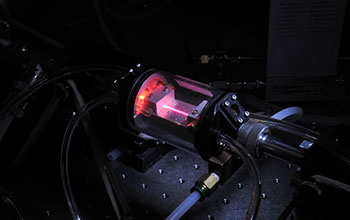Multimedia Gallery
Waveguide filled with high-pressure helium gas as X-ray beam is generated
The hollow waveguide filled with high-pressure helium gas as an X-ray beam is generated. This experimental setup used to create a coherent version of the Roentgen tube in the soft X-ray region of the spectrum. When a long-wavelength femtosecond laser is focused into this hollow waveguide filled with high-pressure helium gas, part of the laser is converted into an ultrafast, laser-like, X-ray beam.
More about this image
For the first time, researchers have produced a coherent laser-like directed beam of light that simultaneously streams ultraviolet light, X-rays and all wavelengths in between. One of the few light sources to successfully produce a coherent beam that includes X-rays, the technology is the first to do so using a setup that fits on a laboratory table.
An international team of researchers, led by engineers from the National Science Foundation's (NSF) Engineering Research Center (ERC) for EUV Science and Technology, reported their findings in the June 8, 2012, issue of Science.
By focusing intense pulses of infrared light--each just a few optical cycles in duration--into a high-pressure gas cell, the researchers converted part of the original laser energy into a coherent super-continuum of light that extends well into the X-ray region of the spectrum.
The X-ray burst that emerges has much shorter wavelengths than the original laser pulse, which will make it possible to follow the tiniest, fastest physical processes in nature, including the coupled dance of electrons and ions in molecules as they undergo chemical reactions, or the flow of charges and spins in materials.
"This is the broadest spectral, coherent-light source ever generated," says engineering and physics professor Henry Kapteyn of JILA at the University of Colorado at Boulder, who led the study with fellow JILA professor Margaret Murnane and research scientist Tenio Popmintchev, in collaboration with researchers from the Vienna University of Technology, Cornell University and the University of Salamanca.
[Research supported by NSF grant EEC 0310717.]
To learn more about this research, see the NSF News Release All the colors of a high-energy rainbow, in a tightly focused beam. (Date image taken: 2011; date originally posted to NSF Multimedia Gallery: Dec. 22, 2017)
Credit: Tenio Popmintchev, JILA and University of Colorado Boulder
See other images like this on your iPhone or iPad download NSF Science Zone on the Apple App Store.
Images and other media in the National Science Foundation Multimedia Gallery are available for use in print and electronic material by NSF employees, members of the media, university staff, teachers and the general public. All media in the gallery are intended for personal, educational and nonprofit/non-commercial use only.
Images credited to the National Science Foundation, a federal agency, are in the public domain. The images were created by employees of the United States Government as part of their official duties or prepared by contractors as "works for hire" for NSF. You may freely use NSF-credited images and, at your discretion, credit NSF with a "Courtesy: National Science Foundation" notation.
Additional information about general usage can be found in Conditions.
Also Available:
Download the high-resolution JPG version of the image. (4.5 MB)
Use your mouse to right-click (Mac users may need to Ctrl-click) the link above and choose the option that will save the file or target to your computer.

 All images in this series
All images in this series